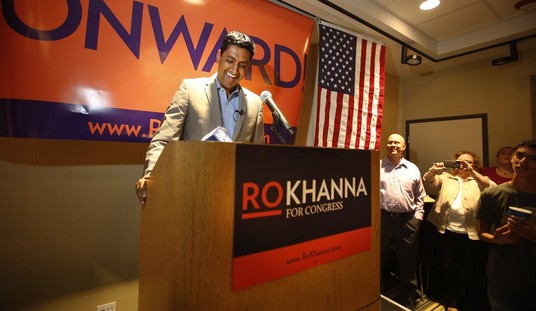Anyone who understands risks pools and pricing opacity could have seen this coming all along … and many of us did. Those who insisted that forcing everyone into insurance would lower costs, or at least those who believed that promise, are in for a rude surprise. Now that insurers have seen the usage rates from the first two years of ObamaCare, they have recalculated premiums to cover the actual costs of providing insurance under a mandate, and Americans will end up with much heftier bills — one way or the other:
Hold onto your wallets … many insurers want to substantially hike rates on Obamacare policies for 2016.
Many are proposing double-digit premium increases for individual policies, with some companies looking to boost rates more than 60%, according to a list posted Monday by the federal Centers for Medicare & Medicaid Services. …
Insurers say they want to hike rates because enrollees are going to the doctor, getting lab work and filling prescriptions more than they had originally anticipated.
“We’ve seen a great pent-up demand for services,” said Aaron Billger, spokesman for Highmark, a Blue Cross Blue Shield licensee offering plans in Pennsylvania, Delaware and West Virginia. Enrollees in Obamacare exchange plans use more healthcare than those in job-based policies, he noted.
Pent-up demand? To some extent, sure. However, it may well be that the pricing opacity provided by insurance on routine care has encouraged more usage by members. That means more costs for insurers, who then have to either charge higher premiums to cover the outlays or use higher deductibles to force customers to pay more up front.
ObamaCare offers another level of opacity on top of that. For most consumers, even the premium gets partially obscured by subsidies that are pegged to cover premium costs (but not deductibles!) above a certain percentage of income. The price hikes on premiums will get absorbed by taxpayers, which means that (a) the red ink will flow even higher, and (b) taxes and fees will have to increase in order to cover the fact that this is a net-deficit program. On top of that, most of these plans feature deductibles for non-wellness care that end up making “comprehensive” insurance equivalent to extremely overpriced catastrophic coverage, only while discourage HSAs and spending tons of taxpayer dollars in subsidies to cover up that reality.
The other supposed cost control in ObamaCare was Medicaid expansion and hospital write-offs. Expanding Medicaid, ObamaCare advocates argued, would reduce emergency room visits for routine issues, allowing hospitals to concentrate on actual emergency issues, and greatly improve profitability by allowing visits to be billed to insurance. We already know that the predicted decline in ER visits never materialized, and the Wall Street Journal reports that neither did the improved financials:
The health law’s expansion of Medicaid in many states hasn’t benefited nonprofit hospitals in those states as expected, according to a new report by Moody’s Investors Service.
Hospitals in the mostly blue states that expanded Medicaid were largely expected to benefit from fewer unpaid bills and more paying customers, but that hasn’t generally translated into better operating margins or cash flow, Moody’s found.
That’s not to say that the financials for hospitals haven’t improved — they have, Moody’s found. However, they attribute the performance improvement to the general economic recovery rather than ObamaCare or the Medicaid expansion. How do they know that? Because financials for hospitals outside of the expansion have improved just as much:
In expansion states, hospitals’ unpaid bills fell 13% on average last year compared with 2013, the report found. But, their 2014 operating margins didn’t increase any more than hospitals in the 22 states that have sat out the expansion, the report shows.
In fact, the Medicaid expansion has created even more problems for those hospitals:
“We did see a significant decrease in” unpaid bills, said Michael Kasser, chief financial officer of Southern Illinois Healthcare, which runs three hospitals southeast of St. Louis. “The bad news is, we saw such a huge increase in Medicaid,” he said, noting that the program pays only about half the hospital’s costs, on average.
He said the hospitals saved about $9 million in unpaid bills, but incurred around $28 million in costs for Medicaid patients, only about half of which was reimbursed by the state-run program. The result: Losses of around $5 million, despite expansion.
The Obama administration and HHS Secretary Sylvia Burwell insist that the program is “working,” even though at 10.1 million paid enrolled it has fallen far short of its original 2015 goal of 13 million enrollees, as CNBC notes. Guy Benson isn’t impressed:
Many Americans find themselves battered not only by still-climbing rates, but by heavy out-of-pocket costs and so-called “access shock.” … In other words, the White House is terribly excited to have exceeded its (massively downgraded) goal, evidently hoping that people forget about previous projections and benchmarks. More than 1.5 million Obamacare sign-ups eventually declined to pay for the coverage they’d selected, dropping out of the pool. Also, healthcare wonk Avik Roy has pored over the administration’s enrollment figures and estimates that only a fraction of the overall number represents newly enrolled Americans. A large number of enrollees previously had insurance prior to Obamacare, then had their coverage cancelled by the law — another notorious broken promise.
The consequences of this inevitable failure of the ObamaCare model puts Democrats in a tough spot. They have to decide whether it’s better to have this hit in October 2015 right before the primaries, or try to delay the inevitable and possibly have it hit in 2016 right before the general election. Of course, just because premiums spike upward this year doesn’t mean they won’t escalate sharply in 2016 for the 2017 plans too. As Investors Business Daily’s editors point out, the structure of ObamaCare practically guarantees it:
But as IBD and others have noted, ObamaCare’s insurance regulations virtually guaranteed a rate spiral. The reason is that ObamaCare bans insurance companies from denying coverage or charging more for those who have pre-existing conditions.
We pointed out that several states had already tried these “guaranteed issue” and “community rating” reforms, and they’d been a disaster. Higher premiums encouraged the young and healthy to forgo insurance, knowing that they could sign up after they got sick, which drove premiums still higher.
ObamaCare was supposed to avoid this fate by heavily subsidizing insurance premiums and imposing a tax penalty for going uninsured, to get the young and healthy to sign up and keep premiums down.
But when IBD’s Jed Graham looked at the limited number of filings two weeks ago, he noted that insurers were asking for hikes that averaged 18.6%. And as more rate filings became public, that picture hasn’t changed.
In all of these scenarios, Democrats thoroughly own the misery — and Republicans have an opportunity to find a plan behind which they can unite to get rid of ObamaCare in favor of market-based reform.
Update: North Carolina’s exchanges will hike premiums twice as much by percentage as they did last year.







Join the conversation as a VIP Member